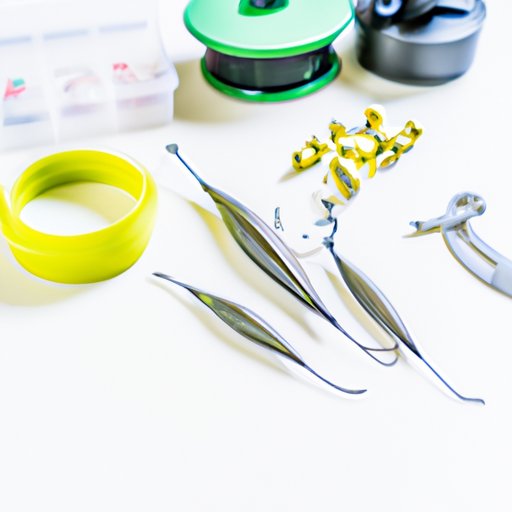Introduction
Setting up your fishing line properly is an essential part of the fishing process. It can be the difference between a successful and unsuccessful fishing trip, so it’s important to take the time to understand how to set up your fishing line correctly. In this article, we will discuss why setting up your fishing line is important, provide a step-by-step guide on how to do it, and offer some essential tips for getting the perfect set up.
Step-by-Step Guide to Setting Up Fishing Line
Before you begin setting up your fishing line, you’ll need to make sure that you have the necessary equipment. This includes a fishing rod, reel, line, and lures or baits. Once you’ve gathered all your supplies, you’re ready to get started.
The first step in setting up your fishing line is to prepare the line. You’ll want to remove any kinks or knots in the line, as these can affect the performance of your reel. Then, attach the line to the reel using a knot, such as the uni-knot or the improved clinch knot. Make sure that the knot is tight and secure before continuing.
Next, you’ll need to secure the line by tying a stopper knot at the end of the line. This will help keep the line from slipping off the reel when casting. After the stopper knot is in place, you’re ready to spool the line onto the reel.
When spooling the line, you’ll want to make sure that it’s even and that there aren’t any kinks or knots in the line. If there are, you may need to cut the line and start over. Once the line is spooled properly, you’re ready to go fishing!
A Beginner’s Guide to Setting Up Fishing Line
If you’re new to fishing, it’s important to understand the basics of setting up your fishing line. The first thing you’ll want to do is choose the right type of line. Monofilament and braided lines are both popular choices, but they each have their own advantages and disadvantages. You’ll also want to consider the size and strength of the line, as this will affect the performance of your reel.
Another important factor to consider when setting up your fishing line is the type of knot you use. There are a variety of knots that can be used for different purposes, such as the uni-knot and improved clinch knot. It’s important to practice tying these knots until you feel comfortable with them, as this will help ensure that your line is secure and won’t slip off the reel when casting.

Essential Tips for Setting Up Fishing Line
Once you’ve got the basics down, there are a few other things to consider when setting up your fishing line. One of the most important factors is the length of the line. The line should be long enough to reach the desired depth, but not so long that it becomes unmanageable. You should also make sure that the line is spooled properly, as this will help prevent tangles and knots.
It’s also important to check the line regularly for signs of wear and tear. If the line is frayed or damaged, it should be replaced immediately. Finally, it’s important to remember that different types of lures and baits require different weights of line, so make sure to choose the right one for the job.

How to Get the Perfect Set Up for Fishing Line
Getting the perfect set up for your fishing line can be the difference between success and failure, so it’s important to pay attention to the details. Choosing the right lure or bait is essential, as is using the appropriate weight. You should also take into account the water conditions, as this can affect the performance of your line.
All You Need to Know About Setting Up Fishing Line
Setting up your fishing line doesn’t have to be complicated, but there are a few common mistakes that beginners make. One of the most common mistakes is failing to tie the correct knot, which can lead to the line slipping off the reel when casting. It’s also important to know when to change your line, as worn or damaged line can affect the performance of your reel.
Finally, it’s important to remember to take care of your line. This means storing it in a cool, dry place and inspecting it regularly for signs of wear and tear. Taking the time to properly care for your line will help ensure that it’s always in good condition and ready to use.
Conclusion
Setting up your fishing line correctly is an essential part of successful fishing trips. Taking the time to understand the basics of setting up your line, choosing the right equipment, and following essential tips can help ensure that you get the perfect set up every time. With the right knowledge and preparation, you’ll be able to enjoy many successful fishing trips.


